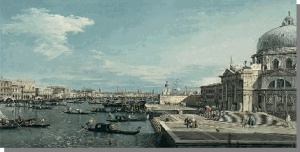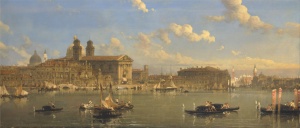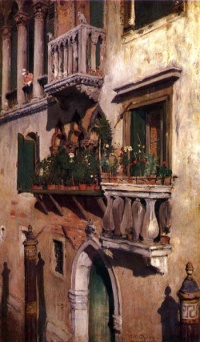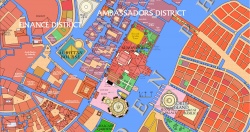Aurice
Aurice is the capital and namesake of the Noble Republic of Aurice and the seventh most populous city of the known world with 630,000 inhabitants. In the Pallathantic Region, Aurice is third most populous after Trevirs and Bryndyd. The highest offices of the government of the imperial apparatus are found in Aurice as well as the government of the Aurician Metropolis. Historically, Aurice has been considered part of Goscundy in Throvy, but it is administratively part of the Aurician Metropolis, an independent political entity under the direct rule of the Noble Senate of Aurice.
Aurice rests upon a flotilla of islands connected by hundreds of bridges and criss-crossed by a network of canals called 'rivens' and for this reason has been amenable to a considerable merchant marine for many centuries. Aurician merchants are world-famous for traversing the world-island, trading with Sungo, Opaz, Zephasia, Bahuna, and far-off Skaligdæ and thus creating a world-class emporium in the city proper. Today's skyborne merchants piloting titancraft-driven vessels have continued this tradition, circumnavigating the globe. Aurice is not only an imperial capital but a leading financial center of the Pallathantic and financial heart of the Aurician Empire.
Aurice traces its origins to settlement by Pallathantic fishermen about two thousand years before Salmakhamer. Archeologers can tell us little about what indigenous culture occupied the islands before the Pallathantic immigration. Archeology gives considerable evidence that Kalaman influence rose and fell with the fortunes of their rulers among the isles of the Addanine Sea. The islands of Aurice proper remained separate villages through the Midretassene and Yophenthean Periods until the fifteenth century when they united for mutual protection from sky piracy and sea raiders. After the collapse of the First Kalikán Empire, the ruling families formed a Senate that elected a duke to govern the city in 1417. Duke and Senate continued to rule and project the power of the mercantile metropolis into Goscundy and the rest of Throvy. With the invasion of uhlak tribes and other nomads, lands of Throvy fell and their loss economically weakened Aurice. Chaos wizards came forth and promised to stave off the marauders of the steppes. Prince Ulcanov through the turmoil of the Middle Ages of Chaos arose and became self-appointed tyrant of the city for about one hundred fifty years. The champions of the Fifth Isbajath slew him and overthrew his power, restoring self-government under the Senate. The city was subsequently ruled by Incarnandist Warriors, Medibgö, Thrace, House Bijäl, and finally under the unshared power of the Senate in 2627 as a result of the Aurician Revolution. The victors of the Battle of Aurice ensured the liberty of the city from the Gorcorumbese Empire during the Fifth Geddamin War. Today Aurice occupies an immensely powerful position of rulership in the eastern Pallathantic which is contested by the rising might of the Adamantine Giants and partisans of independence in Erserce and eastern Corundy. The increasingly powerful role of wealthy, international Corpora Mercia is displacing the pre-eminence of the Noble Senate.
Chronology of Aurice
These are the highlights of Aurician history.
- 1417 Ruling Houses, forming a Senate, elect the first independent Duke of Aurice
- 2627 Aurician Revolution
History
The islands of Aurice are thought to have formed from the ancient flow of the Ibrew River before the rise of sea levels when Magdeologers believe the mouth of the river was located immediate south of the islands of Aurice. The channel known today as the Golden Phœnice River is thought to have been a one of the tributaries of the ancient delta of the river, now almost completely submerged.
Government and Administration
The Noble Senate of Aurice is the origin of all constitutional power over the city. The core islands of Aurice are part of the administrative entity known as the Aurician Metropolis which includes the islands of the Aurician Lagoon and the islands of the north perimeter of the Addanine Sea. These islands are divided into numerous vicifs. Each vicif is permitted to elect a magistrate called a vicevile who represents the needs and the concerns of the vicif before the magistrates appointed by the Senate. The municipal government consists of the body of viceviles, the Lord Mayor of the Metropolis, and the various city magistrates.
Vicifs
The city proper of Aurice has twenty seven vicifs and there are over a hundred more for the remaining islands of the Aurician Metropolis.
Transportation
Foot transportation and water vessels are the traditional means of communication in the city. Aerobarge transit has become vital to the city and there are six private lines regulated by the municipal government.
Key Sites
The imperial city of Aurice offers numerous historic sites. The head of the imperial apparatus, offices for some of the largest corpora mercia in the Pallathantic, and religious temples may be found in Aurice.
Aurician Bourse
The Aurician Bourse is the imperial marketplace for pledgefasts for Corpora Mercia. Deftcantor
Basilica of Saint Gidhoniel
Court Bijäl
Great Basilica
Gubernatorial Palace
Magitechnic Institute of Aurice
Ministry of Corpora Mercia
Presidium of the Republican Guard
Senatorial Palace
Temple of the Golden Phœnice
Lodging and Dining Establishments
- The Black Cannon
- Dostromio’s Public House
- The Golden Lantern Hostel and Fine Tavern
- The Goscund Bard
- The Lucid Fish
- The Muddy Pearl
- The Old Republic
- Starona’s Tavern
- Wetdock Establishment Drinkers
Economy
Aurice is located at the mouth of the Aurician Lagoon and is a gateway city by means of the Ibrew River to the near interior of Asdauria. Aurice is a key entry point into the Pallathantic for many luxury goods from the far east, including illegal euphorium. By virtue of the empire's control of Agogia and Bijälenland, the Aurician Bourse is the leading center for trading such commodities as panox. In combination with Aurice's control of the Grand Shadew Canal, the city is the mistress of the eastern Pallathantic. Additionally, Aurice is the leading human manufacturer of titancraft and competes fiercely with dwarven titancraft manufacturers.
Institutes of Higher Learning
Galdimesan Archguild Museum of Aurice
Festivals and Commemorations
Aurician holidays may be divided into three kinds, state, major, and minor. State observances require all non-essential municipal and city offices and services to be closed. State holidays have some great significance to the state. Major holidays are usually religious and observed by a majority or a large segment of the inhabitants. Minor holidays have a small base of observers, but may be very significant culturally or may have a long standing history of observance.
Games of High Summer

No doubt can exist in the mind of any Aurician that the Games of High Summer on the first of the year is most awaited throughout the prior year. The city becomes packed with provincials and foreigners who must book their lodging as much as a year in advance. Municipal Gendarmes detest the day and are famous for all manner of excuses to be found on holiday on a holiday. All manner of amusements, races, and gambling on the races take place. Aurician game riots are legendary. The rivens and fundaments of the city swell to unbearable depths, particularly around the main riven, Golden Phœnice Riven, where the teams of gibgibsews and their riders gather for the great games.
St. Iphimba's Day
The day of Saint Iphimba of Aurice is honored on 12 Mistmoon which is during Autumn. The day originally honored Saint Iphimba and other Aurician children who died under the sick cruelty of the Dark Prince but has come to be a day to remember all children and infants suffering anywhere. It is a minor holiday and often an occasion for civic leaders to discuss social justice for vulnerable members of society.
Customs
Aurician Broge
See Also
| This article is a stub. It requires further development by the creator. |


